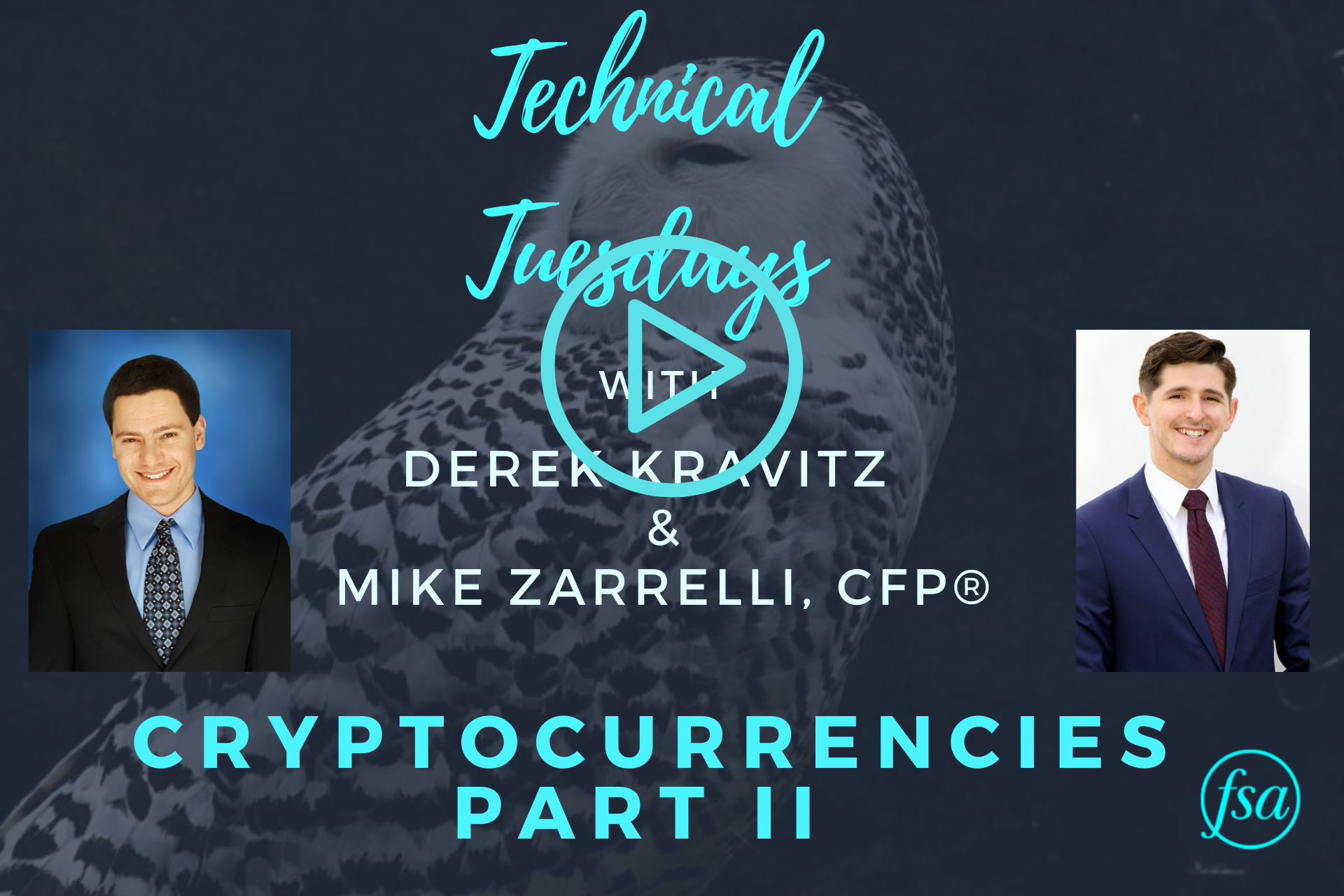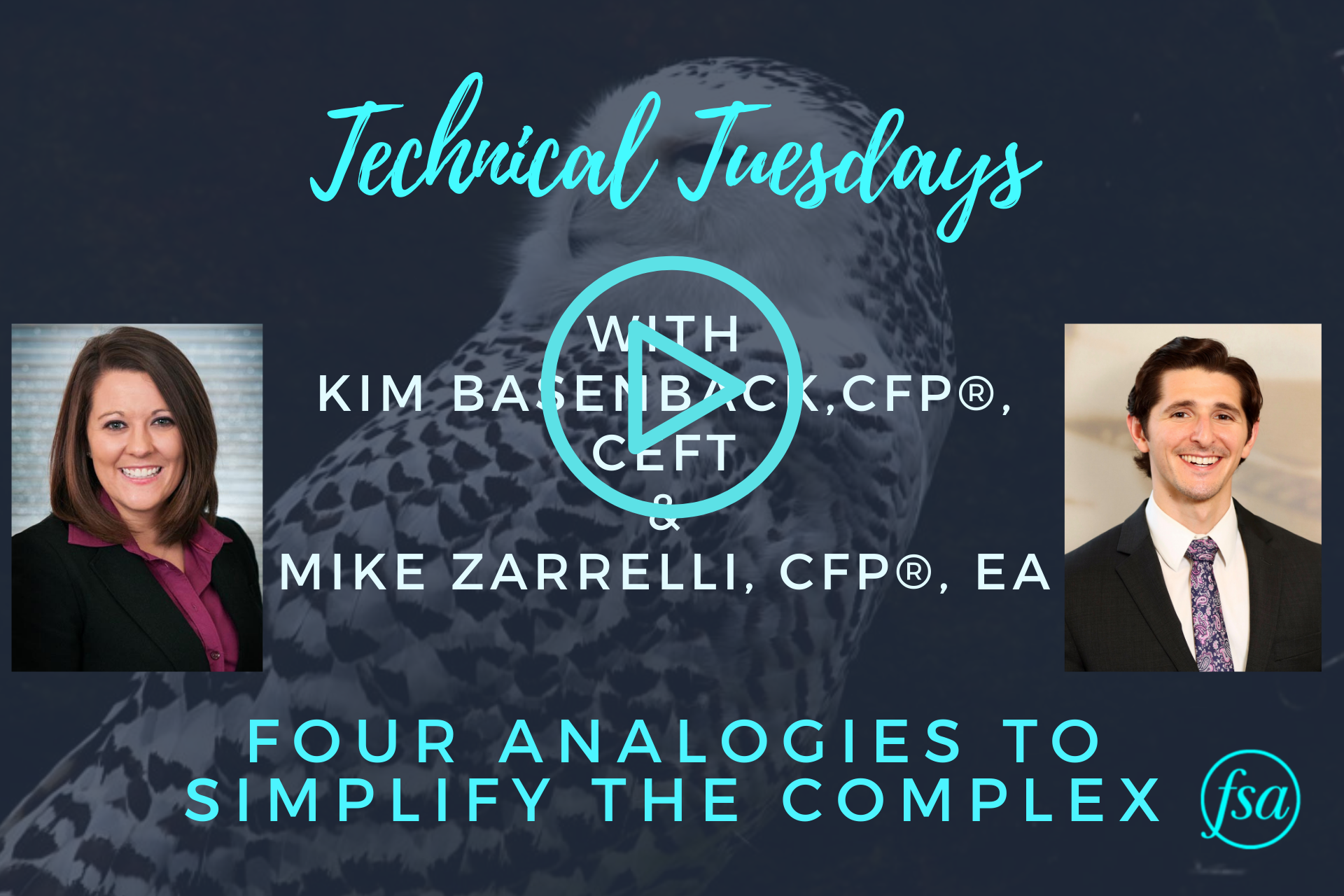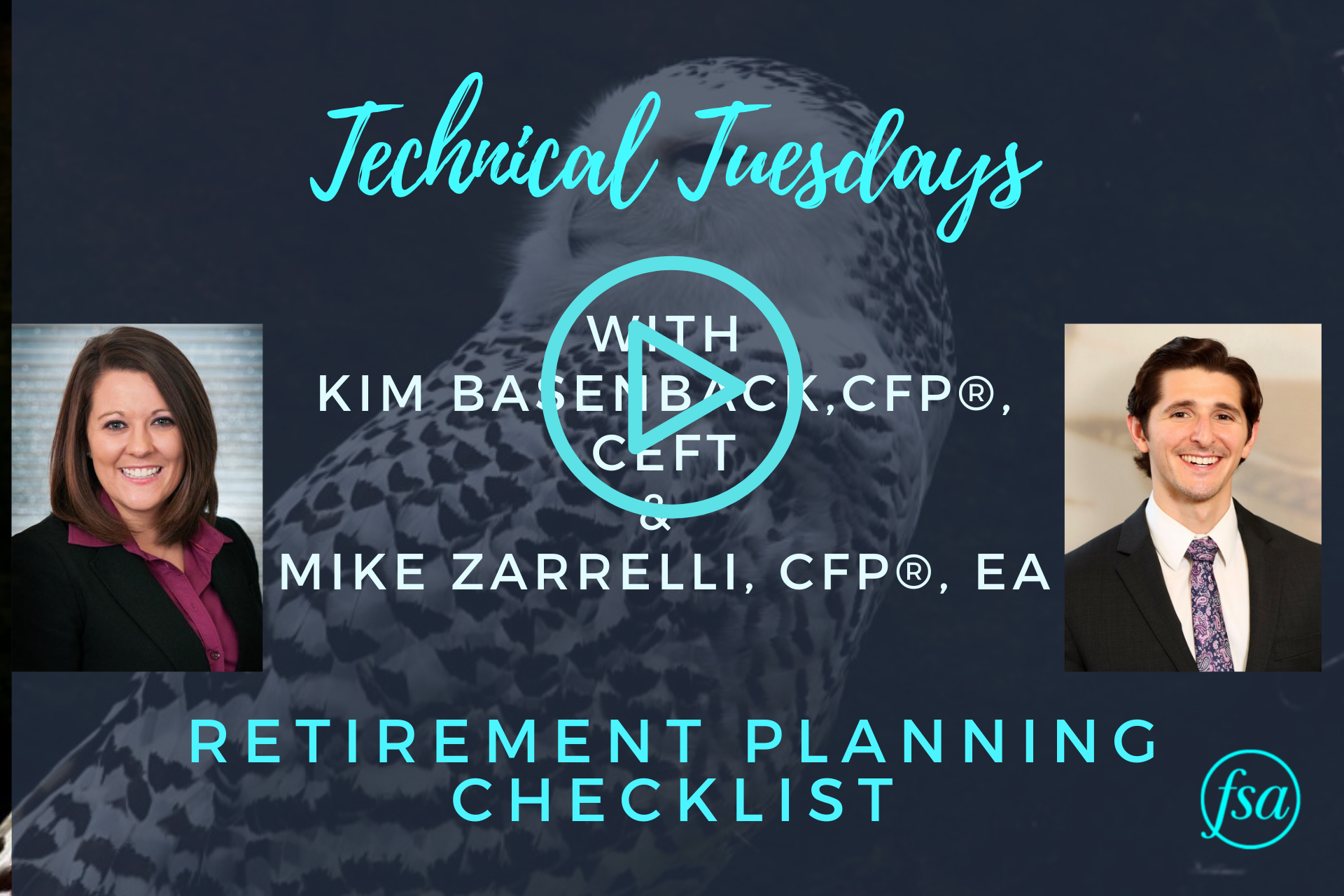In this Technical Tuesdays video, Mike Zarrelli and Derek Kravitz continue their discussion on Bitcoin and cryptocurrencies.
CRYPTOCURRENCIES PART II TRANSCRIPT
Mike:
Welcome back to Technical Tuesdays. We’re going to do a part two of our Bitcoin/cryptocurrency video. I have Derek here today. Hey, Derek, how’s it going?
Derek:
Hey, Mike. Good to see you.
Mike:
Yeah, right back at you. Derek, I heard that you were doing a little lecture video on blockchain and cryptocurrency, so I wanted to start there.
Derek:
Yeah, Mike, so after our last episode where we covered just the very basics of cryptocurrencies, I went down the rabbit hole, and I started watching a open source YouTube series of lectures that were given by the current Chairman of the Securities and Exchange Commission, Gary Gensler, when he was a professor at MIT, and he taught a course on blockchain and cryptocurrencies, and it’s all available for free on YouTube. It’s a little old, but the principles are still relevant and accurate, and we’ll put a link to that in the YouTube description below, but it was fascinating. I learned a bunch about all different aspects of cryptocurrencies and blockchain. And I figured we’ll start off this video just diving a little bit deeper into what is blockchain. You’ve probably heard that term; we even referenced it in our first video. We didn’t really dive into it, but it is what makes cryptocurrencies – it is one part that makes cryptocurrency so interesting, and that is that blockchain is basically a distributed ledger that shows all of the transactions. It shows all of the ownership of the coins at any one point in time, and it cannot be changed, so that’s kind of what’s really special about that.
Now, if you think about gold, you have to go and mine gold out of the ground somewhere. Well, you may have also heard of Bitcoin miners, and all they are are participants on the network that used their computing power to verify that all of the transactions that are happening are legitimate. Now, every single miner, they have to ensure that their ledger matches everyone else’s, and that’s kind of what’s neat about this is that everybody has a copy of this ledger and it all has to match. And these miners are human verifies and ensures that they all match, and they get paid in Bitcoin or whatever cryptocurrency that we’re talking about to provide that functionality. So, it’s just kind of like a very interesting aspect of Bitcoin, so we’ll start there. I know that’s a lot, does that sort of answer your question, Mike?
Mike:
Yeah, definitely. We didn’t even mention miners last time, and sometimes the mining thing doesn’t quite make sense to me, but I’m working on understanding it better. Just to kind of exemplify how big and small blockchain can be, it’s used every day. Even if you go to a restaurant nowadays, sometimes they’ll have a little QR code that you can use your phone and scan to see the menu. That is a form of blockchain, much simpler than what Bitcoin uses, but nonetheless, it is blockchain, so that’s pretty cool.
Well, since our last video, the market for crypto has been nuts. Derek, do you want to just dive into the price action since then?
Derek:
Yeah, definitely. Well, it’s really funny, Mike, because it seems almost like we published our first cryptocurrency video at the top of the crypto markets in April. Basically, Bitcoin got to around 65,000 per coin, and then it promptly fell to a little bit below 30,000 per coin. So, I mean, that’s about a 50% draw-down. The second largest cryptocurrency, Ether, also fell by about a similar margin. I mean, just an amazing amount of volatility that’s still within this asset class. So yeah, it’s been a very volatile summer. We’ve seen a bit of a rebound since then, but it has been a wild ride to say the least.
Mike:
Yeah, definitely a roller coaster. If you can’t stomach the stock market’s rollercoaster, then the Bitcoin/cryptocurrency rollercoaster is not for you. It’s funny. The word on the street is that, Derek, you bought some Bitcoin and maybe some Ether. You want to tell us about your experience first time buying?
Derek:
Yeah, definitely, Mike; so, it’s funny. I did buy some after our first video. I thought what the heck, let me take the plunge here and dip my toe in and get more experience about this. We’re in the investment management industry. I felt like the least I could do is put a little money to work in this just to see what the process is like. So I did. I opened an account, and I funded it with $200, and I split it evenly, 50% in Ether, 50% in Bitcoin. I bought those on May 8th, and both of those coins it sort of pulled back a little bit from their April peaks, but little did I know that there was still a lot more downside ahead of me, and actually we’re putting up a chart here that shows my account values since my investment. And you can see that I was up just a little bit in the very beginning, and then I proceeded to lose about half of the account value in a matter of days which is incredible. Again, just driving home the volatility in this asset class. Now, there has since been a rebound as you can see in the chart, but what’s funny is that my account value is still down at least 10% from where I started. I mean, it’s still not great. I’m still underwater here, so I’m hoping it rebounds, but the point is, put in just a little bit of money, just to get my feet wet, and see how this whole thing works, and it’s been a perfect example. You could just imagine if instead of 200 it were 20,000 or 200,000 or some much larger amount. I mean, it’s just incredible this volatility. So yeah, this is what I wanted to share, and I think it’s more entertainment than anything at this point. I’m not losing sleep over it, but this is why we say making sure that the investment into this new, exciting, yet scary asset class, it should be an appropriate size that fits your risk tolerance and parameters. So yeah, that’s what I’ve got, Mike. What do you think?
Mike:
Yeah, I think you hit it spot on. I mean, especially with any speculative assets, never put in more than you’re willing to lose. Two hundred bucks, a hundred bucks, whatever it is, that’s nothing to lose sleep over in case the worst happens. My story is similar to yours. I started in September of 2020, or not September, January of 2020, when Bitcoin was at $3,000 a coin. I bought $50 worth, so similar to you, very low amount and there’s been a lot of highs since then, a lot of lows, but my strategy has been to dollar cost average. It’s what I do with the stock market, so I decided to do it with cryptocurrencies as well. And that way the day-to-day gyrations, the price actions don’t really mean much. I’m a long-term investor, so I’m hopefully looking at 30 years from now, and hopefully Bitcoin’s at a higher price than it is now by then. But just to drive that point home, never put more than you can afford to lose in a speculative asset.
Derek:
Yeah, I fully agree. And the dollar cost averaging approach is interesting because obviously nobody has any idea what this is actually worth. We’re still in the very early stages, so I think it does help to average in at different prices. Now if I were, obviously hindsight is 20/20, but if I were to go back and redo my experience over the summer with crypto, I would have bought maybe $25 on day one, $25 on day 10, $25 worth on day – obviously given the volatility this summer, there would have been more opportune buying points, but nonetheless, I think your strategy is good. And just for the viewers at home, these are strategies that work for us, or in Mike’s case, it works for him. We highly suggest that you speak with your advisor to form a game plan for yourself if you are considering dabbling in cryptocurrencies. And nonetheless, I think it’s an interesting approach, Mike.
Mike:
Well, since our last video, there’s been a lot of news articles going out about cryptocurrency. Any that come to mind that you want to share with the viewers?
Derek:
Yeah, so the big one that’s got me excited is, obviously we heard about Tesla putting Bitcoin on their corporate balance sheet. That’s actually not what has me excited. The news that excited me was that El Salvador announced that they would be adopting Bitcoin as legal tender, so that means that you can actually pay for goods and services in El Salvador using Bitcoin now or your taxes there, et cetera. I mean, it’s really fascinating what they’ve done, and they’ve rolled out over 200 Bitcoin ATMs, and you might think, “Well, that’s kind of funny. It’s a digital asset. How could you possibly pull out a physical representation of that?” And the answer is that it converts to US dollars. El Salvador uses the US dollar as their currency now, so this is just going to allow folks to keep Bitcoin in a digital version, and then if they want to pull that out, it converts to dollar.
So, why would El Salvador do this? Well, the reason is is that El Salvador’s economy relies heavily on remittances from the United States. What does that mean? There’s a lot of El Salvadorian workers in the United States making money and then sending some of it back home to El Salvador to their families there. So, whenever you send money internationally, what tends to happen? Well, you end up paying some sort of transaction fee somewhere along the way. And if you send enough money, that transaction fee starts amounting to real dollars. And I think El Salvador said something like this would end up saving the country $400 million a year in transaction fees, which is obviously huge, especially for a developing country that’s not super wealthy yet. Every bit helps.
So, the president’s a young guy; I think he’s about 39 years old, and so he’s got a bit of an open mind to cryptocurrency, and I think that he pushed this initiative, and it’s going to be fascinating to see whether it achieves his goals or if there ends up being maybe unintended consequences that outweigh the benefits. You can think about folks who own a lot of cryptocurrency moving there or using it as a place to launder money. I don’t know what’s going to happen yet; it’s going to be fascinating to see. I wish them all the best because if the president’s goals are achieved there this would be a huge boom for their economy. So anyway, that’s what’s had me excited over the summer on the cryptocurrency front.
Mike:
Yeah, pretty exciting news.
Derek:
Now, I know you’ve also been watching headlines in this space, too, with something here at home.
Mike:
Yeah, yeah. So, you’ve probably heard about the $1 trillion infrastructure bill that was being fought about in the Senate. Well, you may ask yourself, how are they going to fund this $1 trillion infrastructure bill? And the answer to that question is with a provision to formally tax cryptocurrencies. Now, the same way that if you buy a stock at 10 and it grows to 12, you’re going to owe taxes on that $2 gain. Well, it’s just the same thing applies to cryptocurrencies. If you buy Bitcoin at 10, it goes to 12, you pay taxes on that $2 gain in Bitcoin. Now, what has people worried is their definition of a broker. Now, if you don’t know what a broker is, a broker just arranges as the exchange between the buyer and the seller. So, for an easy example, Schwab. Charles Schwab is a broker that arranges for us, the buyer and the seller of a mutual fund or an ETF.
Now, with crypto assets, they made a very, very broad definition of broker, so this includes Coinbase, which would be a real broker, the miners that you mentioned earlier, software engineers, so for those miners, each time that they mine more Bitcoin or another crypto asset, they need to send tax reporting documents to the IRS. And people are worried that this is going to stifle innovation because of those high regulatory hurdles that they’ll need to pass. A Bitcoin miner could just be one person with a bunch of computers, and they don’t have a tax department that handles those tax reporting documents.
So the worry is that it just might stifle innovation or discourage people from getting into the crypto game. There were a lot of revisions to that provision that didn’t actually make it in. There’s at least two or three that were trying to make a smaller definition of broker so it’s more accurate and more applicable, but those edits needed 100% approval from the Senate to actually make it into the bill, and they got 99 out of 100 votes yes and one person shot it down. Luckily, it’s going over to the House where it still has a chance to get revised, and then it will make its way back to the Senate where they can have that discussion again, but it did have the crypto community up in arms, but I’m sure something will get figured out before the infrastructure bill is actually passed.
Derek:
Very interesting stuff. Yeah, I had heard something about that, so thanks for cluing us in about that. Yeah, we’ll have to see what the final bill says and what the ramifications are, but that’s obviously a really important aspect of this whole thing, is the government’s going to get their cut. And I do want to go back and say one interesting thing about the El Salvadorian situation is that the country has exempted capital gains from being taxed on your Bitcoin holdings. So, if you are a citizen there and your worry is, “Well, if I convert my US dollars into Bitcoin and it rises, and then I have to pay taxes on it, then I don’t really have as much money as I think I do.” And they’re just saying, “Don’t even worry about it because currencies aren’t meant to be taxed anyway.” So, they’ll exempt citizens from paying tax on it. So I just thought that was a really interesting aspect of that, too. We have the US dollar here, we don’t use Bitcoin as a currency here yet. And so, we will be assured that the IRS will get their cut one way or another, so it’s just interesting which way they’re going to go about that.
Mike:
Yeah, absolutely.
Derek:
So, I think we covered a good bit in part two here. Mike, is there anything else you’d want to hit on before we sign off?
Mike:
Yeah, the last message I just want to give out to the viewers is know what you’re about to buy, do research, do the lecture video that Derek has been watching, read articles, do podcasts, whatever information you get your hands on, go do it before you buy. You never want to go into something blind. And then once you are comfortable and you feel like you know what you’re investing in, take $100, put it in, see if you can stomach the volatility. And if you can, then talk to your advisor from there and see if you can devise a plan, what makes sense, just given your individual scenario. But again, never risk more than you can afford to lose. But yeah, it’s an exciting new thing.
Derek:
Yeah, definitely. And I’ll just echo you, Mike. I mean, lean on us here at FSA if you have questions, concerns, interests in this space, don’t hesitate to reach out. As always questions@fsainvest.com or reach out to your advisor. We’ll be happy to chat with you about this stuff.
FSA’s current written Disclosure Brochure and Privacy Notice discussing our current advisory services and fees is available at www.FSAinvest.com/disclosures or by calling 301-949-7300.




